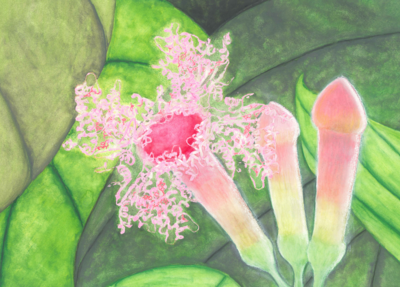Art:Quinine: Barking up the right tree
From Proteopedia
Behind the Artwork and the Protein Structure
This image shows the flowers of the cinchona tree, with the cytochrome P450-quinine complex in place of the opening flower. This beautiful pastel drawing was created by Anna Valchanova, a student formerly of Stephen Perse foundation school in Cambridge.
View in 3D or go to PDB structure 4wnv [1]
Cytochrome P450
The cytochrome P450s (CYPs) are a remarkably diverse group of enzymes. Over 50,000 distinct CYPs have been identified across all kingdoms of life. Their enzymatic reactions catalyse the reduction of a huge variety of different substrates. They are involved in the biosynthesis pathways of numerous important compounds in nature including hormones, cholesterol and vitamin D. They are also crucial in metabolising a whole range of toxic compounds. Plants have a particularly high diversity of CYPs, and the genes which code for them may make up as much as 1% of plant genomes, highlighting the large number of potentially toxic compounds which plants create.
All CYP reactions involve the transfer of electrons via a bound haem group. It’s that haem which gives the P450s their name as it absorbs light at 450nm when it’s reduced. In fact, the reactions of the CYP enzymes centre around that vital haem ligand. This haem group is coordinated to the protein via a cysteine thiolate linkage to the iron at the centre of the haem. The cysteine is highly conserved throughout all CYPs, as are many of the flanking residues, with the active site arrangement consistent across the whole family. The substrate binds on the opposite side of the haem and accepts electrons from it, with a molecule of water produced at the end. The broad specificity of this enzyme is what enables this family to be so diverse.
Quinine
Some human CYPs are able to breakdown quinine by hydroxylation of the molecule to a less toxic form, 3-hydroxyquinine. However, there have also been studies that suggest that quinine can also inhibit the action of certain CYPs. Quinine is used as a treatment for malaria as it is extremely toxic to Plasmodium falciparum, the organism that causes the disease. The mechanism of action is not well understood, however it is thought that it may interfere with the ability of P. falciparum to utilise haemoglobin. It is found in relatively high amounts in the bark of the cinchona tree and is a key ingredient of tonic water. The effectiveness of quinine as a treatment was first documented almost 400 years ago by Jesuit missionaries in South America, with it referred to as ‘Jesuit’s bark’ in older documentation. While it is no longer the primary treatment for malaria but still plays a significant role as a secondary treatment in more complex cases. The main drawback for quinine as a treatment for malaria are the number of unpredictable side effects it can have. This is mainly due to high doses affecting the blood and cardiovascular system in humans.
Explore the scientific publication
- ↑ Wang A, Stout CD, Zhang Q, Johnson EF. Contributions of Ionic Interactions and Protein Dynamics to Cytochrome P450 2D6 (CYP2D6)Substrate and Inhibitor Binding. J Biol Chem. 2015 Jan 1. pii: jbc.M114.627661. PMID:25555909 doi:http://dx.doi.org/10.1074/jbc.M114.627661

